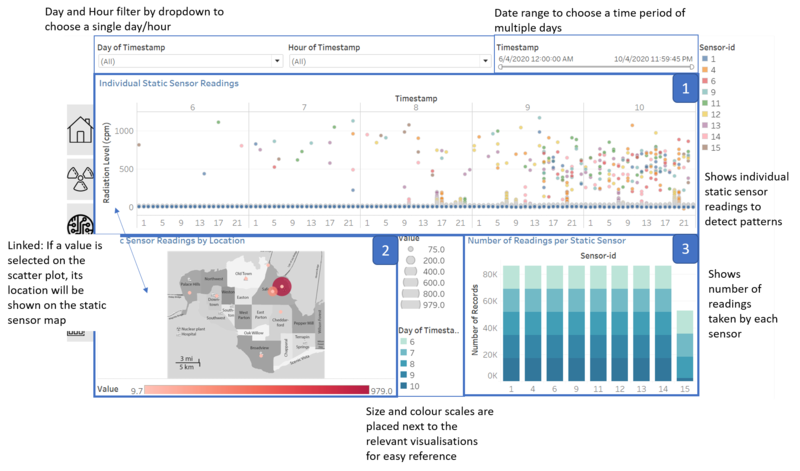IS428 AY2019-20T1 Assign Lee Cheng Leng Visualisation 2
Jump to navigation
Jump to search
|
|
|
|
|
|
|
|
|
|
|
|
|
Contents
Dashboard 2: Detailed Analysis of Static Sensor Data
Component 1: Scatter Plot of Individual Sensor Readings
Purpose
- Shows the radiation concentration levels over time by hourly basis for readings from the 15 static sensors.
- Allows study of uncertainty of the static sensor data
- Allows identification of any spikes or trends in radiation levels recorded by static sensors.
Description
- User can view the individual sensor readings, which is more accurate than taking an aggregate measure of the radiation readings. This is because taking an aggregate measure such as average might reduce the possibility of identifying data outliers.
- Colour palette used to differentiate the radiation readings originating from different sensors.
Component 2: Static Sensor Locations
Purpose
- Provides a visual representation of the locations of which each static sensor is located
- Allows the user to associate the radiation levels to its relative location in St. Himark.
Description
- User is able to click on one of the locations on the map, and the corresponding sensor's readings will be highlighted on the scatter plot. This would be useful in helping them to obtain a closer look at the behaviour of a particular sensor.
- Usage of image map would show the sensor's position on the St. Himark map easily.
Component 3: Number of Radiation Readings Recorded by Each Sensor
Purpose
- Allow comparison between the uptime of each static sensor based on the number of readings recorded
Description
- Using a stacked bar graph, we would be able to see the part-whole relationship of the number of records obtained per day in the simulation, as a part of the total number of readings obtained.
- This would allow us to compare the reliability of different sensors, such that we would know which sensors might be uncertain and hence would need further analysis.

